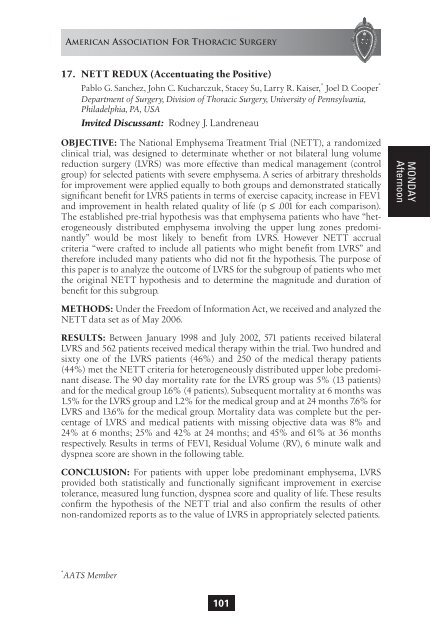Boston - American Association for Thoracic Surgery
Boston - American Association for Thoracic Surgery
Boston - American Association for Thoracic Surgery
- No tags were found...
You also want an ePaper? Increase the reach of your titles
YUMPU automatically turns print PDFs into web optimized ePapers that Google loves.
AMERICAN ASSOCIATION FOR THORACIC SURGERY17. NETT REDUX (Accentuating the Positive)Pablo G. Sanchez, John C. Kucharczuk, Stacey Su, Larry R. Kaiser, * Joel D. Cooper *Department of <strong>Surgery</strong>, Division of <strong>Thoracic</strong> <strong>Surgery</strong>, University of Pennsylvania,Philadelphia, PA, USAInvited Discussant: Rodney J. LandreneauOBJECTIVE: The National Emphysema Treatment Trial (NETT), a randomizedclinical trial, was designed to determinate whether or not bilateral lung volumereduction surgery (LVRS) was more effective than medical management (controlgroup) <strong>for</strong> selected patients with severe emphysema. A series of arbitrary thresholds<strong>for</strong> improvement were applied equally to both groups and demonstrated staticallysignificant benefit <strong>for</strong> LVRS patients in terms of exercise capacity, increase in FEV1and improvement in health related quality of life (p ≤ .001 <strong>for</strong> each comparison).The established pre-trial hypothesis was that emphysema patients who have “heterogeneouslydistributed emphysema involving the upper lung zones predominantly”would be most likely to benefit from LVRS. However NETT accrualcriteria “were crafted to include all patients who might benefit from LVRS” andthere<strong>for</strong>e included many patients who did not fit the hypothesis. The purpose ofthis paper is to analyze the outcome of LVRS <strong>for</strong> the subgroup of patients who metthe original NETT hypothesis and to determine the magnitude and duration ofbenefit <strong>for</strong> this subgroup.MONDAYAfternoonMETHODS: Under the Freedom of In<strong>for</strong>mation Act, we received and analyzed theNETT data set as of May 2006.RESULTS: Between January 1998 and July 2002, 571 patients received bilateralLVRS and 562 patients received medical therapy within the trial. Two hundred andsixty one of the LVRS patients (46%) and 250 of the medical therapy patients(44%) met the NETT criteria <strong>for</strong> heterogeneously distributed upper lobe predominantdisease. The 90 day mortality rate <strong>for</strong> the LVRS group was 5% (13 patients)and <strong>for</strong> the medical group 1.6% (4 patients). Subsequent mortality at 6 months was1.5% <strong>for</strong> the LVRS group and 1.2% <strong>for</strong> the medical group and at 24 months 7.6% <strong>for</strong>LVRS and 13.6% <strong>for</strong> the medical group. Mortality data was complete but the percentageof LVRS and medical patients with missing objective data was 8% and24% at 6 months; 25% and 42% at 24 months; and 45% and 61% at 36 monthsrespectively. Results in terms of FEV1, Residual Volume (RV), 6 minute walk anddyspnea score are shown in the following table.CONCLUSION: For patients with upper lobe predominant emphysema, LVRSprovided both statistically and functionally significant improvement in exercisetolerance, measured lung function, dyspnea score and quality of life. These resultsconfirm the hypothesis of the NETT trial and also confirm the results of othernon-randomized reports as to the value of LVRS in appropriately selected patients.* AATS Member101
















